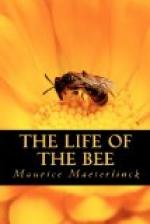The same naturalist cites yet another proof of the bees’ lack of intelligence, and discovers it in the following quotation from the great American apiarist, the venerable and paternal Langstroth:—
“As the fly was not intended to banquet on blossoms, but on substances in which it might easily be drowned, it cautiously alights on the edge of any vessel containing liquid food, and warily helps itself; while the poor bee, plunging in headlong, speedily perishes. The sad fate of their unfortunate companions does not in the least deter others who approach the tempting lure from madly alighting on the bodies of the dying and the dead, to share the same miserable end. No one can understand the extent of their infatuation until he has seen a confectioner’s shop assailed by myriads of hungry bees. I have seen thousands strained out from the syrups in which they had perished; thousands more alighting even on the boiling sweets; the floors covered and windows darkened with bees, some crawling, others flying, and others still so completely besmeared as to be able neither to crawl nor to fly—not one in ten able to carry home its ill-gotten spoils, and yet the air filled with new hosts of thoughtless comers.”
This, however, seems to me no more conclusive than might be the spectacle of a battlefield, or of the ravages of alcoholism, to a superhuman observer bent on establishing the limits of human understanding. Indeed, less so, perhaps; for the situation of the bee, when compared with our own, is strange in this world. It was intended to live in the midst of an indifferent and unconscious nature, and not by the side of an extraordinary being who is forever disturbing the most constant laws, and producing grandiose, inexplicable phenomena. In the natural order of things, in the monotonous life of the forest, the madness Langstroth describes would be possible only were some accident suddenly to destroy a hive full of honey. But in this case, even, there would be no fatal glass, no boiling sugar or cloying syrup; no death or danger, therefore, other than that to which every animal is exposed while seeking its prey.




